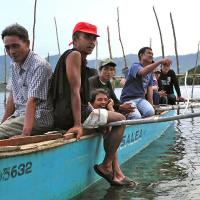Marine Life Encyclopedia
Cephalopods, Crustaceans, & Other Shellfish
Antarctic Krill
Euphausia superba
Distribution
Circumpolar in the Southern Hemisphere
ECOSYSTEM/HABITAT
Open ocean (pelagic)
FEEDING HABITS
Filter feeder
TAXONOMY
Subphylum Crustacea (crabs, shrimps, and relatives), Family Euphausidae (krill)
The Antarctic krill is an extremely common, pelagic crustacean native to the waters surrounding Antarctica and is one of the most important prey species near the bottom of Southern Ocean food webs. It can form dense aggregations, and scientists believe the total combined biomass of this species to be as much as several hundred million metric tonnes – more than that of all humans. Several species of Southern Ocean foragers and predators specialize on Antarctic krill as one of their primary food sources.
Antarctic krill are filter feeders that eat tiny phytoplankton (pelagic algae). They use their small, hair-like legs to filter out these microscopic algae that bloom in the nutrient-rich waters around Antarctica. These blooms are densest at the ice edge, so Antarctic krill are often also densest near that system. Few species as large as the Antarctic krill can eat food that small, so this krill provides an important link to higher levels in the food web. Blue whales and other large whales, leopard seals and other seals, several species of penguins, albatrosses and other seabirds, several fish species, and squids and other invertebrates all eat huge numbers of Antarctic krill. Without this species, Southern Ocean food webs would completely collapse. The Antarctic krill is the keystone species throughout its range.
This krill reproduces by a behavior similar to internal fertilization. The male deposits a packet of sperm on the female’s body, and as she releases her eggs, they pass through the sperm and become fertilized. Like in all crustaceans, the Antarctic krill’s shell is a skeleton on the outside of its body. This exoskeleton does not expand, and therefore individuals must molt (=shed) it regularly in order to grow bigger. Before molting, an individual begins building a new, larger skeleton inside the existing one. As it gets too big to be contained, it splits open the outer shell, and the new exoskeleton hardens.
The conservation status of the Antarctic krill is unknown, but as it is one of the most common species in its range, it is not at risk of endangerment or extinction. However, a fishery has recently been developed, and any change to Antarctic krill populations resulting from this human activity will affect the numerous species – many of which are at risk – that rely on Antarctic krill as their primary food source. Some scientists believe that changes to this species’ populations have affected the recovery of the Blue Whale, in particular, even though that species has not been hunted commercially for 50 years.
Additional Resources:
Get Involved
Donate Today
SUPPORT OUR WORK TO PROTECT THE OCEANS BY GIVING TODAY
With the support of more than 1 million activists like you, we have already protected nearly 4 million square miles of ocean.
TAKE ACTION NOW
Support policy change for the oceans
Decision-makers need to hear from ocean lovers like you. Make your voice heard!
VISIT OUR ADOPTION CENTER
SYMBOLICALLY ADOPT AN ANIMAL TODAY
Visit our online store to see all the ocean animals you can symbolically adopt, either for yourself or as a gift for someone else.
DOWNLOAD OCEAN ACTIVITIES
HELP KIDS DISCOVER OUR BLUE PLANET
Our free KELP (Kids Environmental Lesson Plans) empower children to learn about and protect our oceans!



